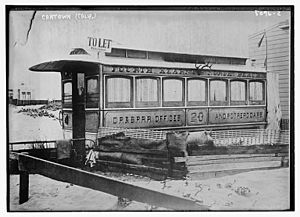Carville, San Francisco facts for kids
Carville, also known as Carville-by-the-Sea, was a very unusual neighborhood in San Francisco. It existed in the late 1800s and early 1900s. This area is now part of the Outer Sunset District. People in Carville lived in old, abandoned horsecars and cable cars. They used these old trolleys for homes and other buildings. Carville was located near 47th Avenue and Lawton Street. It was just south of Golden Gate Park.
How Carville Started
In the mid-1800s, San Francisco used horse-drawn railcars on its streets. But then, newer cable cars and electric streetcars arrived. This meant the old horsecars were no longer needed.
In 1895, the Market Street Railway Company had many old horsecars. They placed an ad in the San Francisco Examiner newspaper. They offered to sell these horsecars for just $20 each. If you didn't want the seats, they were only $10.
People quickly found many uses for these old cars. Some became children's playhouses in backyards. Others were used as real estate offices or shoemaker shops. Some even became shelters for people in need in North Beach.
The First Car Homes
Colonel Charles Dailey and his wife moved to the area in 1893. This part of San Francisco was mostly sand dunes back then. They rented a plot of land from Adolph Sutro, a famous San Francisco landowner.
Colonel Dailey rented a horsecar from Sutro. He turned it into a "coffee saloon" called "The Annex." This shop served visitors who came by train to Ocean Beach and the Cliff House. This coffee shop became the very first car-home in the area.
Soon, more people started moving to this unique spot. A real estate agent named Jacob Heyman began renting out lots. You could rent a lot for $7.50 a month. For $35, you could get a lot that included two horsecars! By 1897, the area was known as "Carville-by-the-Sea" or simply "Carville."
Life in Carville
The old streetcars became homes and businesses. Some people used just one car for their home. Others were more creative. They put together many cars, sometimes as many as ten! They built multi-story buildings and U-shaped structures with courtyards.
Even churches were made from these old cars. St. Andrews by the Sea Episcopal Church was built using horsecars from different lines. Even when cars were covered by other building materials, you could often still see their original shape inside.
Carville attracted many different kinds of people. Some were poor and needed affordable housing. Others were artists and writers, sometimes called "Bohemians." One person, Dr. Cross, ran a clubhouse there. Famous writers like Jack London and George Sterling visited this club. Another group of musicians ran a club called La Bohème. They even hosted opera singers visiting from New York!
Jacob Heyman also helped improve Carville. He set up a water supply from a well. By 1900, the price to rent a lot with two cars had gone up to $600.
The End of Carville
By 1900, about 2,000 people lived in Carville. But as San Francisco grew, the land around Carville became more valuable. People wanted to build more traditional homes there.
A group called the Oceanside Improvement Club wanted to modernize the area. In 1913, they held a special event. They ceremonially burned four of the old car-homes. Most of the Carville neighborhood was gone by the 1920s.
Today, it's possible that a few Carville-style buildings still exist. However, only one is widely known to remain.



